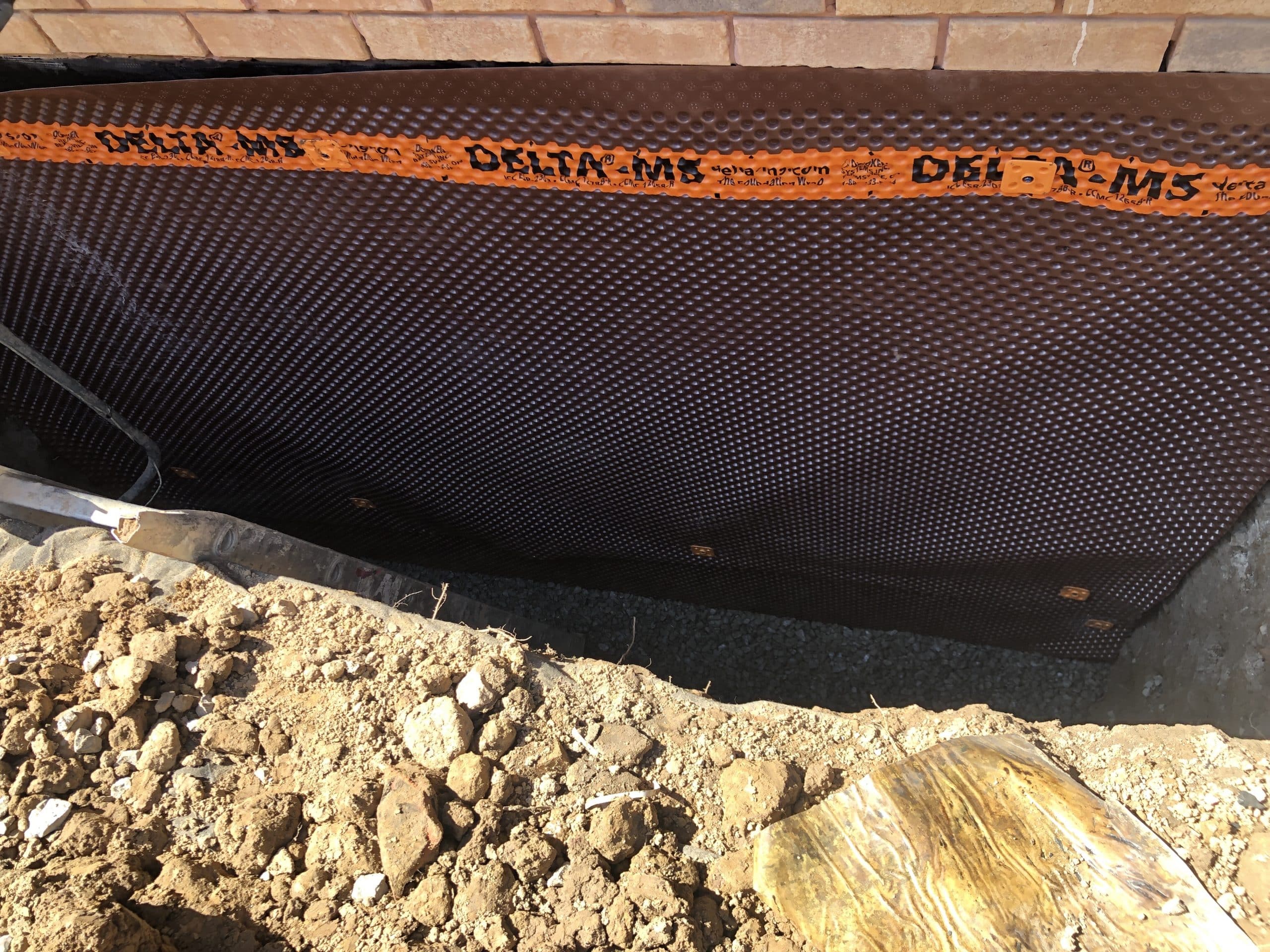Waterproofing house refers to the process of making any structure or object water-resistant so that it remains unaffected by water. It resists the infiltration of water under specific conditions.
Waterproofing is different from damp-proof where waterproof generally refers to the penetration of water in its original liquid state and damp proof relates to being resistant to dampness or humidity.
Waterproofing is very necessary in order to protect your building or home from water damage, mildew, foundation issue. There are times when the water gets leaked or the basement gets wet when there are excessive rains. Waterproofing is required by building codes for all those structures that are built at below ground level. When a situation like high water table arises or where the groundwater is likely to be accumulated in the soil, waterproofing and drainage considerations become very important.
The reasons that are responsible for water leaks and seepage:
Rains are always welcomed and are good for the garden, but they are equally unwelcomed if all the water gets leaked into your basement. After a heavy snow or rain, water gets accumulated inside the window wells. This happens when the installation of the window well is not properly done or in case the drain gets clogged. This water build-up can lead to cracks and leaks through basement window seams. Water stains on the walls are the signs indicating leaky basement windows.
When there are heavy and consistent rains, the soil gets saturated. This soil saturation results in the creation of hydrostatic pressure/water pressure which has the strength to push water and moisture through basement walls and floor.
The soil that is lying loose around your foundation tends to absorb too much water. Also, the area around the home gets flooded with rainwater. This water gets accumulated as a result of clogged gutters or downspouts that are discharging water right next to the foundation. When the soil gets expanded, lateral pressure is created against the foundation. This pressure damages the foundation of home and results in leaks in the basement.
How does water get into the basement?
The water that is present in the soil results in hydrostatic pressure that gets exerted under the basement floors as well as walls. This hydrostatic pressure does the rest of the work. Water gets into the basement with any of the below-mentioned paths:
- Via cracks present in the walls or floor
- Via cracks that are present in the mortar joints of masonry or block foundation walls
- At the joint where the walls meet the poured concrete floor
How to stop water leakage?
There are several methods that we can use for diverting the water that has already penetrated a foundation or preventing the water from penetrating the basement foundation as a prevention step. We will see a few of them:
Improvement in grading
It is very important to ensure that the soil surrounding the house is pitched away from it. This is to be done in a way that the water gets drained towards the yard and not the foundation.
Cleaning the gutters
When it rains heavily, the gutters that are clogged can overflow and as a result of this overflow, the rainwater gets accumulated around the foundation. For preventing this from occurring, first of all, all the debris and leaves should be removed and leaf guards should be installed. Also, downspout extenders should be installed to direct the water away from the house. All these steps will help in preventing the soil around the house from being saturated.
Window wells should be repaired
For repairing the window wells, a fitted window well cover can be installed. This is a very simple yet effective solution that will keep the window wells free of leaves and other debris which can cause clogging of drain resulting in water seeping into your basement.
Interior Sealants
These interior sealants refer to the interior walls and floor sealers. When it comes to pouring a concrete foundation, seepage finds their entry through cracks and pipe penetration. These penetration points can be sealed from the interior. For this, Epoxies and Urethane’s can be used which blocks the water penetration where Epoxies are strong adhesives and Urethane’s are pressure injected into these openings. This will penetrate the foundation through to the exterior and as a result cuts off the seepage path.
But if your house is built upon the masonry foundation, these interior sealants will not be much effective. The reason is that these interior sealers cannot protect against water infiltration in the areas having hydro static pressure. The interior sealants are experts in preventing high atmospheric humidity that is present within the basement from absorbing into the masonry that has gone porous and is causing spalling. Spalling is referred to a condition where moisture or high humidity that is persistent results in breaking down of masonry surfaces causing the concrete areas to shed or deterioration.
Interior Water Drainage
Installing Interior Drainage System is considered as one of the most effective ways to keep water out of the basement which will help in minimizing the hydrostatic pressure.
Though interior water drainage is not something that can be technically referred to as waterproofing, the research has accepted it as a technique in mitigating basement water, popularly referred to as a Basement Waterproofing Solution. Many of the drainage systems that are being used are approved recognized by Building Officials and Code Administrators (BOCA) and are patented as being effective in controlling the basement water.
The method that is being used for draining all the penetrated water in the basement includes creating a channel. This channel is created along the basement perimeter alongside the footers of foundation. A French drain, PVC Pipe or a patented drainage system needs to be installed in this newly created channel. Then the drain that is installed is covered with new cement.
Through this system, the drainage system will collect all the water that will enter the basement and will drain it into an internally placed Sump Pump system. This will then force the water out of the basement. Foundation wall is fastened with the membranes or wall conduits and extend over the new drainage to guide any moisture down into the system.
Interior Waterproofing
There are several reasons for the basement to get wet but when the basements get wet as a result of condensation, doing interior basement waterproofing along with coatings is considered most effective. This interior waterproofing is quite effective if there is minor dampness but will not be that effective to stop major leaks.
As we know, water also finds its entry through cracks that are not a result of soil expansion from saturation. These basement cracks can be repaired in many different ways, with tons of solutions that are available at any hardware store, but it will not be a permanent fix. First of all, the root of the problem should be addressed. The pressure that is forcing the water into the cracks should be resolved before repairing the cracks. This is important because if this pressure problem is not addressed and the cracks are repaired straightaway, these repaired cracks will allow the water to seep into the basement.
A cove point is referred to as a space between the walls meeting the floor in any room. This cove point is a contender for leaks and cracks. Now since these walls and floors are different pours of concrete, over time, water will make its way through this place and enter into the house resulting in excess water. As a temporary solution, this place can be sealed. The pressure of the water will eventually compromise the sealant and the leaks will be seen again. Such leaks are best to repair permanently and it can be done by repairing the crack on the interior and exterior along with repairing the drainage around the foundation of the home.
Exterior Waterproofing
Preventing any structure from the damage that is caused by the water infiltration can only be prevented by waterproofing that structure from outside. This is the only method that has been recognized by the International Building Code (IBC).
If waterproofing needs to be done on an already existing basement, firstly the bottom sides of the footing need to be excavated. When the excavation is completed, the walls are then powder washed and allowed to dry. When the walls are completely dried, they are then sealed with a waterproof membrane. Thereafter, weeping tiles or new drainage tiles are placed at the side of the footing.
When Drain tile is installed at the point where the floor meets the wall or where most water leakage occurs, it will capture all the water before it makes way onto the basement floor. Also, this drain tile can collect all the water coming from the foundation.
From a decade, waterproof products that are based on the polymer are developed and used widely. These polymer-based products stay for the lifetime and soil pH does not affect them. One can directly spray these polymer-based waterproofing products on the walls and it cures the areas promptly. As they are semi-flexible, they allow the substrate to move a little bit.
Untreated Leaks
Have you wondered what will be the result when the leaks are not repaired? If this water seepage stays untreated, one is potentially allowing the basement as well as the rest of the house to become a perfect breeding ground for moulds and many such hazardous issues. Let us go through some of them:
Mildew and Mold
Mildew and Mold are most commonly found in the areas that have been exposed to moisture. As many types of mould possess spores which when inhaled is hazardous to the health as they cause respiratory problems or trigger allergies.
Stains
Metal surfaces such as steel and iron are most prone to have rust which is, in reality, a reddish flakey layer of iron oxide. This is formed as a result of oxidation that results due to past or present moisture.
Efflorescence
Many times you may see a white mineral deposit that is often fuzzy or powdery. It is typically seen on concrete, brick, and tiles. The masonry material carries the minerals and salts through the water. When this water passes through the wall of the foundation, the minerals that are present within the water get dissolved inside the masonry material. When this water gets evaporated, the minerals are left on the surface on a white, powdery film.
Rotting Wood
When leaking water gets accumulated, it forms moisture and when the wood in such an area gets exposed to this moisture, it causes the wood to rot. Now when this moisture content in the wood crosses the fibre saturation point or it goes beyond 30 percent, wood decay spores find their way to the word surface. These wood decay spores are in the air and when the temperature increases, these spores start germinating and penetrate the wood.
Stained Floors
When the leaks remain untreated for long, it causes discolouration of the floors which becomes quite difficult to remove.
Then one has to bear the additional cost of treating these spoiled areas along with the leakage.












